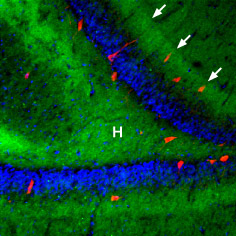Overview
- Peptide DAEAQESH*SNPRC, corresponding to amino acid residues 180-192 of mouse ADRB3 with replacement of cysteine 186 (C186) with serine (*S) (Accession P25962). 2nd extracellular loop.

 Western blot analysis of mouse (lanes 1 and 3) and rat (lanes 2 and 4) brain lysates:1,3. Anti-β3-Adrenergic Receptor (extracellular) Antibody (#AAR-017), (1:200).
Western blot analysis of mouse (lanes 1 and 3) and rat (lanes 2 and 4) brain lysates:1,3. Anti-β3-Adrenergic Receptor (extracellular) Antibody (#AAR-017), (1:200).
2,4. Anti-β3-Adrenergic Receptor (extracellular) Antibody, preincubated with β3-Adrenergic Receptor (extracellular) Blocking Peptide (#BLP-AR017).- Human detrusor lysate (Silva, I. et al. (2020) Br. J. Pharmacol. 177, 1589.).
 Expression of β3-Adrenoceptor in rat hippocampusImmunohistochemical staining of rat hippocampal dentate gyrus using Anti-β3-Adrenergic Receptor (extracellular) Antibody (#AAR-017), (1:100), (green). β3-Adrenoceptor is strongly expressed in the hilus (H) and in the outer molecular layer (arrows). The distribution overlaps the entire layers, but is not restricted to nerve cells (stained red with mouse anti-Parvalbumin). DAPI is used as the counterstain (blue).
Expression of β3-Adrenoceptor in rat hippocampusImmunohistochemical staining of rat hippocampal dentate gyrus using Anti-β3-Adrenergic Receptor (extracellular) Antibody (#AAR-017), (1:100), (green). β3-Adrenoceptor is strongly expressed in the hilus (H) and in the outer molecular layer (arrows). The distribution overlaps the entire layers, but is not restricted to nerve cells (stained red with mouse anti-Parvalbumin). DAPI is used as the counterstain (blue).
- IUPHAR RECEPTOR DATABASE | ADRENOCEPTORS
- Piascik, M.T. and Perez, D.M. (2001) J. Pharmacol. Exp. Ther. 298, 403.
- Evans, B.A. et al. (1999) Br. J. Pharmacol. 127, 1525.
- Klein, J. et al (1999) J. Biol. Chem. 274, 34795.
Adrenergic receptors (also called adrenoceptors) are the receptors for the catecholamines adrenaline and noradrenaline (called epinephrine and norepinephrine in the United States). Adrenaline and noradrenaline play important roles in the control of blood pressure, myocardial contractile rate and force, airway reactivity, and a variety of metabolic and central nervous system functions.
Adrenergic receptors are members of the G-protein coupled receptor (GPCR) superfamily of membrane proteins. They share a common structure of seven putative transmembrane domains, an extracellular amino terminus, and a cytoplasmic carboxyl terminus.
Adrenoceptors are divided into three types: α1, α2 and β-adrenoceptors. Each type is further divided into at least three subtypes: α1A, α1B, α1D, α2A, α2B, α2C, β1, β2, β3. 1,2 Adrenoceptors are expressed in nearly all peripheral tissues and in the central nervous system.1,2
The β3-adrenoceptor is insensitive to the commonly used β-antagonists and has often been referred to as the 'atypical' β-adrenoceptor. Mouse β3-adrenoceptor has two known splice variants; isoforms β3a-adrenoceptor and β3b-adrenoceptor. Both isoforms are expressed in white and brown adipose tissues.3 The β3b-adrenoceptor is highly expressed in brain.
The β3- adrenoceptor has been found to play a key role in the lipolytic action of catecholamines.4
Application key:
Species reactivity key:
Alomone Labs is pleased to offer a highly specific antibody directed against an extracellular epitope of the mouse β3-adrenoceptor. Anti-β3-Adrenergic Receptor (extracellular) Antibody (#AAR-017) can be used in western blot and immunohistochemical applications. It has been designed to recognize both splice variants of the β3AR from mouse, rat and human samples.
Applications
Citations
- Human and rat detrusor lysate.
Silva, I. et al. (2020) Br. J. Pharmacol. 177, 1589.

